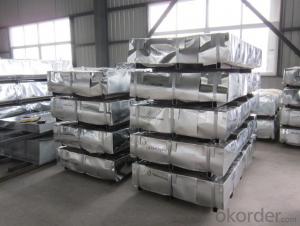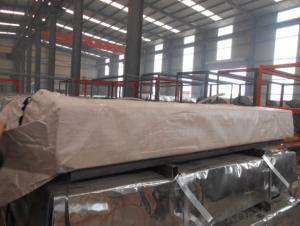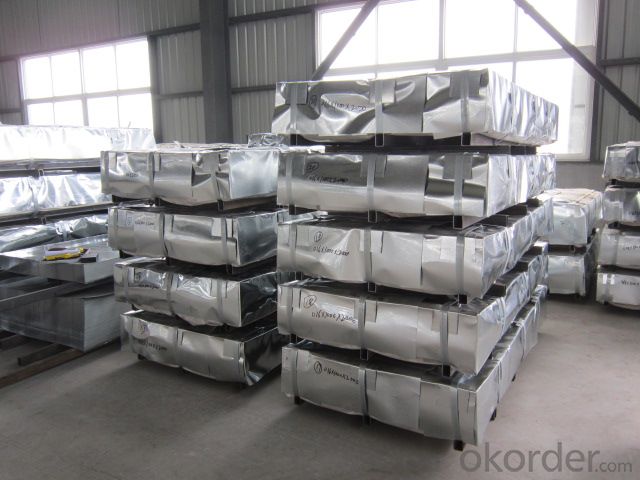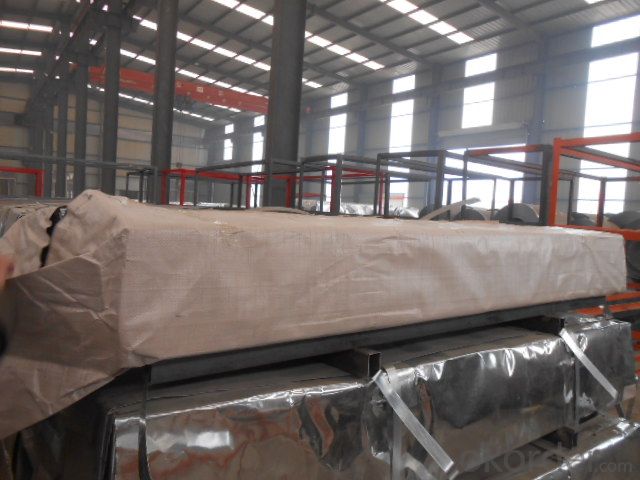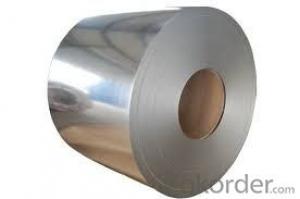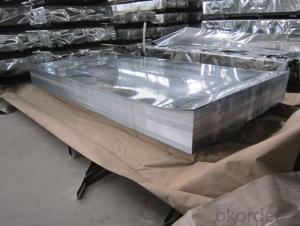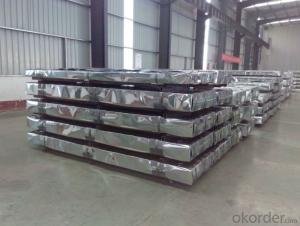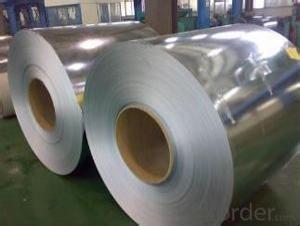Hot-dip Galvanized Steel Sheet in Sheet
- Loading Port:
- Tianjin
- Payment Terms:
- TT OR LC
- Min Order Qty:
- 25 m.t
- Supply Capability:
- 5000 m.t/month
OKorder Service Pledge
OKorder Financial Service
You Might Also Like
Hot-dip Galvanized Steel Sheet in Sheet
Description:
The most external layer is all zinc, but successive layers are a mixture of zinc and iron, with an interior of pure steel. These multiple layers are responsible for the amazing property of the metal to withstand corrosion-inducing circumstances. Zinc also protects the steel by acting as a "sacrificial layer." If rust does take hold on the surface of Galvanized Steel Coil, the zinc will get corroded first. This allows the zinc that is spread over the breach or scratch to prevent rust from reaching the steel.
Architecture Roofs and outside walls of civilian and industrial buildings, garage doors, fencings and window blinds.
1. Good Resistance to Corrosion
2. Qualified Processing Machinability
3. High Thermal Resistance
4. Excellent Reflectivity
Application:
Construction, packaging, railway vehicles, agricultural machinery and daily life.
Oiled/dry, Skin-pass/Nonskin-pass, Regular/Minimize/Zero Spangle
For countless outdoor, marine, or industrial applications, Galvanized Steel Coil is an essential fabrication component.
Architecture Roofs and outside walls of civilian and industrial buildings, garage doors, fencings and window blinds.
Appliances Industry Outer clad sheets for washing machine, refrigerator, television, air conditioner and ventilation system, explosion-proof strip, solar water heater and appliance parts.
Product Specification:
Base sheet : galvanized steel sheet, pre painted galvanized steel sheet
Zinc:40G-275G
Thickness:0.12mm-3.2mm
Width:600mm-1500mm
Length:1000mm-11800mm or as request
Package:Standard seaworthy export packing: 3 layers of packing, inside is kraft paper,water plastic film is in the middle and outside GI steel sheet to be covered by steel strips with lock.
FAQ:
1.How many pieces for one ton of the Hot-dip Galvanized Steel Sheet?
The pieces for one tone is decided by the thickness of the sheet, but we can make it according to your requirements in the reasonable range.
2. Do you have pallets for the package?
Yes, we must use pallets for the package in order to load.
3. How many tons do you load in one 20’FCL?
Usually we can load 26tons in one 20’FCL container.
- Q: What are the different profile options available for steel sheets?
- Some of the different profile options available for steel sheets include corrugated, ribbed, standing seam, trapezoidal, and flat profiles. These profiles are designed to offer various benefits such as enhanced strength, improved water drainage, and aesthetic appeal for different applications in construction and roofing.
- Q: What are the safety precautions when handling steel sheets?
- To ensure the well-being of individuals and prevent accidents while handling steel sheets, it is crucial to adhere to several safety precautions. These precautions encompass: 1. Personal Protective Equipment (PPE): Wearing appropriate PPE is crucial. This typically includes safety goggles or glasses, gloves, and steel-toed boots. PPE safeguards against potential injuries like cuts, burns, and eye damage. 2. Correct Lifting Techniques: Given their weight and awkwardness, utilizing proper lifting techniques is vital to avoid strain or injury. Lift with your legs, not your back, and employ team lifting when necessary. Refrain from abrupt or jerky movements while handling the sheets. 3. Secure Storage and Transport: To prevent shifting or falling, ensure proper securing when storing or transporting steel sheets. Employ suitable equipment like straps or chains to secure the sheets, distributing them evenly for balance. 4. Clear Work Area: Prior to handling steel sheets, clear the work area of obstacles or debris. This minimizes tripping or slipping hazards and enables a smooth path for moving the sheets. 5. Adequate Lighting: Good visibility is essential during steel sheet handling. Insufficient lighting heightens the risk of accidents and injuries, so ensure the work area is well-lit to avert any potential mishaps. 6. Training and Education: Individuals handling steel sheets must receive adequate training and education on safe handling procedures. This entails understanding the weight and dimensions of the sheets, as well as employing correct lifting and moving techniques. 7. Awareness of Sharp Edges: Steel sheets often possess sharp edges that can cause cuts or lacerations. Always handle the sheets cautiously and be mindful of any sharp edges. If necessary, utilize protective guards or edge protectors to minimize the risk of injury. 8. Regular Maintenance and Inspection: Regularly inspect the steel sheets for signs of damage, like sharp edges, rust, or structural weaknesses. Replace or repair any damaged sheets to ensure safe handling. By adhering to these safety precautions, individuals can minimize the likelihood of accidents and injuries while handling steel sheets. Prioritizing safety and taking necessary steps to protect oneself and others in the work environment is of utmost importance.
- Q: How do steel sheets compare to other materials, such as aluminum or stainless steel?
- Steel sheets have distinct advantages over other materials like aluminum or stainless steel. Steel is known for its exceptional strength and durability, making it an ideal choice for applications that require high structural integrity. Compared to aluminum, steel sheets offer superior tensile strength and resistance to impact, making them more suitable for heavy-duty applications. Stainless steel, on the other hand, provides excellent corrosion resistance, but it may not match the strength of steel. Overall, steel sheets are a versatile material that strikes a balance between strength, durability, and cost-effectiveness, making them a popular choice in various industries.
- Q: Can steel sheets be used for manufacturing electrical enclosures?
- Indeed, it is possible to utilize steel sheets in the production of electrical enclosures. The durability, strength, and capability of steel to provide essential safeguarding for electrical components have rendered it a widely employed material for constructing such enclosures. By employing steel sheets, one can ensure that the enclosure possesses robustness and can endure diverse environmental conditions. Furthermore, steel possesses commendable electromagnetic shielding properties, which aid in safeguarding delicate electronic equipment against interference. Additionally, steel sheets are resistant to fire, rendering them appropriate for manufacturing enclosures that must adhere to safety regulations. In summary, steel sheets are a dependable option for fabricating electrical enclosures due to their attributes and appropriateness for the intended purpose.
- Q: Are steel sheets suitable for railway track construction?
- Yes, steel sheets are suitable for railway track construction. Steel is a highly durable and strong material, making it ideal for withstanding the heavy loads and constant traffic of trains. Steel sheets are often used as the base for railway tracks, providing a solid foundation for the rails and ensuring stability and reliability. Additionally, steel offers excellent resistance to wear, corrosion, and deformation, which are crucial factors in maintaining the long-term performance of railway tracks. Its high strength-to-weight ratio also allows for lighter track structures and reduced maintenance requirements. Overall, steel sheets are a popular choice in railway track construction due to their strength, durability, and cost-effectiveness.
- Q: What are the common applications of cold-rolled steel sheets?
- Cold-rolled steel sheets are commonly used in a wide range of applications such as automotive components, appliances, construction materials, furniture, and industrial machinery.
- Q: What is the process of laminating steel sheets?
- The process of laminating steel sheets involves bonding multiple layers of steel together to create a stronger and more durable material. This is typically done by applying heat and pressure to the sheets, which causes them to fuse together. The sheets are often coated with a layer of adhesive or resin before lamination to enhance the bonding process. The result is a laminated steel sheet that exhibits improved strength, resistance to corrosion, and other desirable properties.
- Q: Can steel sheets be used in earthquake-resistant construction?
- Yes, steel sheets can be used in earthquake-resistant construction. Steel has excellent strength and ductility properties that allow it to withstand the forces generated during an earthquake. Additionally, steel sheets can be easily fabricated, assembled, and incorporated into various structural systems, making them a popular choice for earthquake-resistant construction.
- Q: What is the process of embossing on steel sheets?
- The process of embossing on steel sheets involves creating raised or recessed designs on the surface of the steel by applying pressure with specialized tools or dies. This is typically done through a combination of heat and pressure, which allows the metal to be deformed and take on the desired pattern or texture.
- Q: How are steel sheets measured and sized?
- Steel sheets are measured and sized using various parameters such as thickness, width, and length. The thickness is typically measured in gauge or millimeters, while the width and length are measured in inches or feet. Additionally, steel sheets can be cut and customized to specific dimensions as per the requirements of the project or application.
Send your message to us
Hot-dip Galvanized Steel Sheet in Sheet
- Loading Port:
- Tianjin
- Payment Terms:
- TT OR LC
- Min Order Qty:
- 25 m.t
- Supply Capability:
- 5000 m.t/month
OKorder Service Pledge
OKorder Financial Service
Similar products
Hot products
Hot Searches
Related keywords

